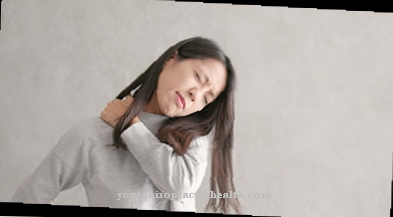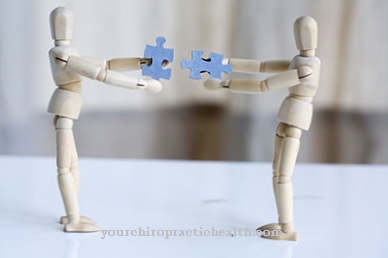Finger misalignments are relatively rare. They are either inherited or occur as spontaneous mutations, which are then also passed on to the offspring. In addition, finger anomalies can result from accidents. They are usually not noticeable externally such as, for example Camptodactylyunless they are severe cases of misalignment.
What is camptodactyly?

© Rob Byron - stock.adobe.com
In the Camptodactyly it is the excessive flexion of the middle joint of a finger. The deformity was first described in 1846. In finger contractures, only the soft tissue structures are shortened. Bony joint parts are only affected in some syndromic camptodactylia. The middle joint of the finger is more or less bent upwards and cannot be actively stretched.
However, greater diffraction is possible without restrictions. The other phalanges are bent towards the palm of the hand because of over-flexion. Camptodactyly thus resembles the clinical picture of the hammer finger. It usually occurs sporadically and occurs symmetrically on both sides on only one finger. Usually the little finger is excessively curved. Occasionally, camptodactyly occurs in the ring finger and - even more rarely - in the middle finger.
The malformation is extremely rare (probability 1: 100,000). Since it is not associated with pain, those affected often hardly feel restricted. Only when the finger bends at an even larger angle is the misalignment perceived as annoying. In most cases it does not manifest itself until between the ages of 10 and 14.
causes
The exact causes of camptodactyly are still unknown. The sporadic form is the result of an accident, a burn (caused by scarring) or is considered a new mutation. New mutations are always inherited in an autosomal dominant manner. Lately, doctors suspect that this includes cases of autosomal recessive inheritance. The genetic finger anomaly is inherited as an autosomal dominant trait. In patients with congenital camptodactyly, the malformation occurs on both sides and affects the same fingers (symmetrical malposition).
In some cases it is also associated with other malformations such as polydactyly (multiple fingers) and hammer toes. Camptodactyly is also a common feature of a genetic malformation syndrome. This is the case, for example, with trisomy 21 (Down syndrome), Zellweger syndrome, Juberg-Marsidi syndrome and Marfan syndrome.
Symptoms, Signs & Ailments
Camptodactyly occurs in an early and a late form. The first signs of early form appear within the first 12 months of the child's life: it shows bilateral and asymmetrical camptodactyly. In the late form, which becomes manifest from the age of 10 and progresses slowly, the degree of flexion of the affected finger increases continuously until the patient is around 30 years old.
In some patients affected by finger contractures, joint pads can be found over the dorsal parts of the joints ("knuckle pads2"). In addition, there are nodular changes under the skin on the volar side of the joint in question. The usual transverse skin folds are also often missing there. In patients with autosomal dominant inherited camptodactyly, an increased excretion of taurine via the urinary tract is also found.
Since the rare finger anomaly is painless and is only associated with functional impairment in a few cases, the patient does not feel hindered by it. The orthopedic surgeon usually does not go to the orthopedic surgeon until the person concerned has a visually conspicuous finger contracture or the pronounced malformation is very difficult.
Diagnosis & course of disease
The specialist can use imaging procedures (X-rays) to assess whether the malformation is mild or severe. The X-ray image shows how much the head of the middle phalanx has tilted on the flexor side. Since camptodactyly is a complex malformation, he usually only advises surgical intervention if the mobility of the finger is significantly restricted. In the course of life, uncorrected camptodactyly can lead to an increase in the flexion angle.
Complications
Camptodactyly usually leads to various misalignments of the fingers. These misalignments can significantly limit the patient's everyday life and reduce the quality of life. As a result, it may no longer be possible to grasp and lift objects. The camptodactyly can also lead to severe pain.
The development of the sick child can also be restricted by this disease. This disability often leads to depression and other psychological disorders, especially in children, when they are bullied or teased because of them. However, camptodactyly does not have to lead to limitations or disabilities in every case.
If the patient does not complain of symptoms, no treatment needs to be carried out. Camptodactyly does not usually limit or reduce life expectancy. The camptodactyly can be corrected with the help of therapies or surgery.
There are no particular complications or complaints. After the procedure, the affected person can use his entire hand normally again. If there is no treatment, there will be no positive course of the disease.
When should you go to the doctor?
Parents who notice malformations of the fingers in their children should consult a doctor. Camptodactyly usually shows up within the first ten to twelve months of the child's life. If treatment is started during this period, the prospect of a symptom-free life is given. You should also see a doctor if you have unusual symptoms, for example if the child cannot grip properly or complains of pain in the hand. If a malformation can be recognized externally, the pediatrician should be consulted immediately.
The child then needs conservative treatment via splinting and physiotherapy. Close monitoring by the doctor is necessary during treatment. If the measures are ineffective, the doctor should be discussed about an operation at an early stage. Camptodactyly should also be checked regularly after surgery. If there is a concrete suspicion of a malformation, parents should contact the pediatrician or family doctor or a sports doctor directly.
Therapy & diagnosis
If the camptodactyly is not very pronounced - if the joint can be passively stretched - most specialists recommend conservative therapy with splinting and stretching exercises (physiotherapy). The individually manufactured splint causes gentle stretching and stretching of the affected finger joint. Treatment is continued until there is a significant improvement in the condition.
If the therapy is unsuccessful, surgery is usually performed. However, since very few surgical interventions show the desired result - the finger is only free to move again in exceptional cases - an operation is usually not recommended. As a rule of thumb, surgery is only recommended if the extension deficit is greater than 30 degrees. The operation is a moderate procedure that is performed under general anesthesia. Without anesthesia, it takes 45 to 90 minutes.
The hand surgeon breaks the affected joint and rewires it. If necessary, the malformation of the tendons or ligaments is corrected. The patient is hospitalized for about two days. Another operation is performed about ten days later, during which the wire is removed. However, this is only a minor intervention. The wound heals with barely visible scarring because the surgical area is very small.
Outlook & forecast
Usually, regular stretching and stretching of the affected finger joint is sufficient to achieve an improvement in both the short and long term. The more intensely these exercises are carried out, the lower the risk that an operative measure will have to be taken.
If, despite all efforts, there is no improvement, an operation may be necessary. Here, the affected person can ensure faster and less complicated healing through good pre- and post-operative care. This includes not using stimulants such as tobacco and alcohol, as well as consulting the doctor with regard to over-the-counter medicines taken. Even if they are apparently harmless homeopathic drugs, these could lead to severe interactions with anesthetics and jeopardize the success of the treatment. Postoperatively, the wound must first be spared and carefully cared for before, after consulting the doctor, you can start again with lighter exercises for better mobility.
If further illnesses or the patient's constitution prevent an operation, treatment with splints or prostheses to immobilize the patient in a stretched position may be advisable, which is also supported with targeted stretching and stretching exercises. Ultimately, it depends not only on the cause and extent of the finger misalignment, but also on the doctor's prognosis, which measures the patient himself can contribute to improvement.
prevention
Prevention is not possible with camptodactyly because it is genetic or occurs as a result of an accident.
Aftercare
As a rule, the follow-up measures for camptodactyly depend heavily on the exact severity and also the cause of the disease, so that no general prediction can be made. However, since this disease is a hereditary disease, it cannot be completely cured. If you want to have children, genetic testing and counseling can be useful to prevent the recurrence of camptodactyly in the descendants.
Self-healing does not occur with this disease, so that the early diagnosis of the disease is in the foreground. The symptoms of the disease are usually alleviated by means of physiotherapy or physiotherapy. In many cases, some of the exercises can be done at home, which speeds up treatment.
A surgical procedure can also be carried out, after which the person concerned should definitely rest and take care of his body. You should refrain from physical or stressful activities in order not to unnecessarily burden the body. Further follow-up measures are often not necessary for camptodactyly. The disease also does not reduce the patient's life expectancy.
You can do that yourself
In the case of camptodactyly, conservative treatment using splints and stretching exercises is usually possible. The doctor will primarily suggest that the patient regularly straighten and stretch the affected finger joint. This is usually enough to improve the condition in the long term.
If the finger misalignment does not improve, an operation is necessary, the success of which the patient can support with good pre- and post-operative care. In preparation for the procedure, the usual measures apply, i.e. the renouncement of stimulants and the examination of drugs that are taken regularly in order to avoid interactions with the anesthetics used. After the procedure, the affected finger must first be spared. In the first few days, the wound should be carefully cared for so that no wound healing disorders or other complications occur.
If surgery is not possible, because the patient suffers from a chronic bone disease, for example, the camptodactyly must be treated with a suitable aid. Prostheses that expand the finger's freedom of movement come into question here. The exact measure that makes sense depends on the cause and severity of the misalignment, but also on the doctor's prognosis.



.jpg)

.jpg)





















